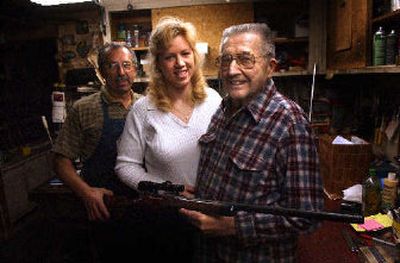Gunmakers shoot for perfection

Editor’s note: This is the third in a series devoted to local craftsmen of distinguished outdoor gear
He began making guns as a hobby at the age of 15. He trained as a machinist and was earning $16 a week grinding optical lenses before moving to Spokane to renew his boyhood fascination with building custom guns.
“I just plugged away,” said Al Biesen. “I don’t know how to explain it, but all of a sudden, some years later, I just found myself as a craftsman.”
Biesen’s claim to fame came after writing a letter to Jack O’Connor in Idaho just after World War II. Al told the famous globetrotting hunter it was about time he had a “good rifle.”
O’Connor decided to take a chance on what he called “a brash young upstart.” The author and gun editor for Outdoor Life could have had guns made by any craftsman in the world. Yet after seeing that first “good rifle,” O’Connor commissioned Biesen to build about 35 rifles and shotguns during the next 20 years.
Word spread. Biesen kept busy enough to work his son, Roger, into the basement shop. Now his granddaughter, Paula, adds the finishing touches to rifles that some collectors consider to be perfect.
Al and Roger have mastered skills from barrel work to stock carving and customizing actions and components. Paula came aboard as the engraver, producing the inlays and designs that transform a classic rifle or shotgun into an art piece.
Family ties: “There were no guarantees,” Paula said, referring to her aspirations as an artist to add her talents to the family business. “This wasn’t one of those occasions where they could praise you because you were related.”
Business philosophy: “When the job is done,” Roger explained, “you’re not just sending out a rifle, it’s your reputation.”
“The workmanship wouldn’t be any different for you than it would be for the Prince of Iran,” he added, noting that Al did indeed build rifles for Prince Abdorreza of Iran and Faisal II, the last king of Iraq.
Distinction: Before suffering a stroke seven years ago, Al hand-checkered wood stocks as casually as he would butter toast. Nowadays, although he still works in the shop several hours a day, Al leaves the fine detail work to Roger.
Checkering is the term for the pattern of diamonds carved in the gripping areas of the stock. It’s just one of the many steps in creating a gun distinguished by absolute uniformity. The checkering often is scratched into prized hunks of English walnut worth $1,000.
“Checkering isn’t necessarily difficult if you have the time,” Roger said. “But you’re asking for trouble if you get in a hurry.”
Why customize a gun? “It’s a personal thing,” Roger said. “Not everybody drives a BMW, but a few people do. Some people just want quality and a perfect fit.”
Projectiles shot from rifles or shotguns customized by the Biesen family gunmakers will not drop game any more effectively than the lead fired from off-the-shelf guns. But the Biesen actions are smoother and less likely to jam, the safeties are precise, and their fit and balance is so perfect they shoulder and point like a fine shotgun.
Sign on shop door: “Business hours subject to hunting season.”
Favorite shotguns: “Anything out of Italy,” Roger said.
Rookie mistake: “Quitting a good job and coming here to work for nickels an hour,” Roger said.
Consumer tip: “If the barrel is worn out on a gun, we’ll try to talk you out of putting a lot of labor into reworking a gun,” Roger said. “There’s no sense putting that much work into something that doesn’t shoot well, even if you’re not going to shoot it.”
Tools of trade: Lathes, files, special wood-carving and cutting tools. Also, a baby scale: “A block of wood requires a year or more to dry before we can make it into a stock,” Al said. “We keep a baby scale and weigh the block every few months. When it quits losing weight, it’s ready.”
Paula’s engraving requires a tool that’s essentially a surgically precise jackhammer. Through the microscope she uses while working, the tool seems to function like a scoop in ice cream.
Giving back: The Biesens recently built a reproduction of Jack O’Connor’s No. 2 sheep-hunting rifle, using a 1959 Winchester Model 70 action, a French walnut stock and featherlight barrel. The rifle raised $16,000 in a raffle to support the conservation efforts of the Idaho Chapter of the Foundation for North American Wild Sheep.
A Biesen rifle with gold inlays by Terry Wallace sold for $110,000 at a Safari Club International fund-raising auction in 1994.
Prized possession: Al worked more than 45 years in the business before taking the time to build a custom rifle for himself.
“I did some work on it; Roger has his hand in it, and we got Paula involved,” Al said. “It might be the best rifle ever for that reason, and because it’s mine.”
Bottom line: Generally, Biesen gun work costs about $3,000 for a custom stock job plus $1,000 for metal work on existing guns with additional costs for exotic woods, engraving and gold inlays as desired. Finished products run about $6,000. If you want the best of everything, such as a thin-shelled Turkish Walnut stock, wildlife engravings and gold inlays galore, the price could run up to $12,000.
Where: Biesen Gunmakers, 2039 W. Sinto Ave., 328-6818.